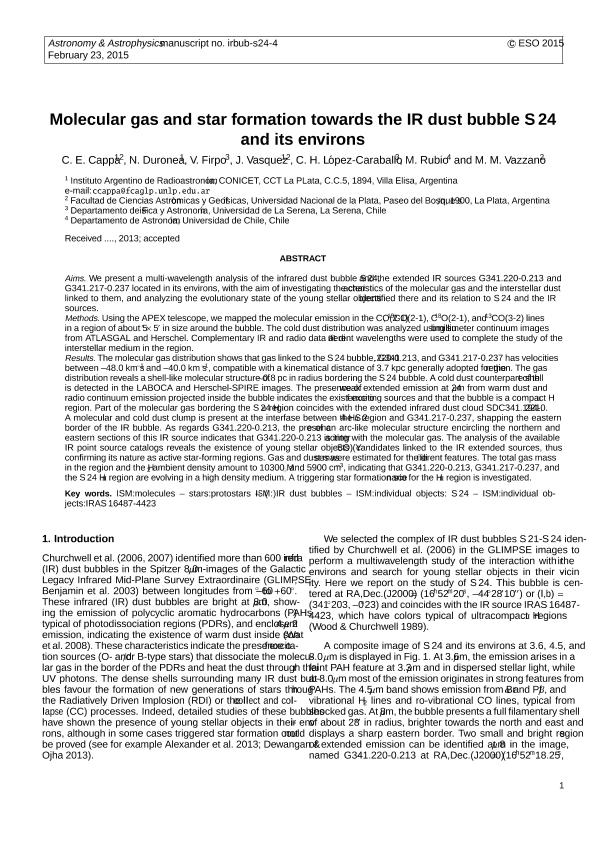Mostrar el registro sencillo del ítem
dc.contributor.author
Cappa, Cristina Elisabeth

dc.contributor.author
Duronea, Nicolas Urbano

dc.contributor.author
Firpo, Verónica

dc.contributor.author
Vasquez, Javier

dc.contributor.author
Lopez Carballo, C. H.
dc.contributor.author
Rubio, Mónica
dc.contributor.author
Vazzano, María Mercedes

dc.date.available
2016-08-08T14:35:47Z
dc.date.issued
2016-01
dc.identifier.citation
Cappa, Cristina Elisabeth; Duronea, Nicolas Urbano; Firpo, Verónica; Vasquez, Javier; Lopez Carballo, C. H.; et al.; Molecular gas and star formation towards the IR dust bubble S24 and its environs; EDP Sciences; Astronomy and Astrophysics; 585; 1-2016; 1-17
dc.identifier.issn
0004-6361
dc.identifier.uri
http://hdl.handle.net/11336/6976
dc.description.abstract
Aims. We present a multiwavelength analysis of the infrared dust bubble S 24 and the extended IR sources G341.220-0.213 and G341.217-0.237 located in its environs. We aim to investigate the characteristics of the molecular gas and the interstellar dust linked to them and analyze the evolutionary state of the young stellar objects identified there and the relation of the bubble to S 24 and the IR sources. Methods. Using the APEX telescope, we mapped the molecular emission in the CO(2-1), 13CO(2-1), C18O(2-1), and 13CO(3-2) lines in a region of about 5′ × 5′ in size around the bubble. The cold dust distribution was analyzed using submillimeter continuum images from ATLASGAL and Herschel. Complementary IR and radio data at different wavelengths were used to complete the study of the interstellar medium in the region. Results. The molecular gas distribution shows that gas linked to the S 24 bubble and to G341.220-0.213 and G341.217-0.237 has velocities of between -48.0 km s-1 and -40.0 km s-1, compatible with the kinematical distance of 3.7 kpc that is generally adopted for the region. The gas distribution reveals a shell-like molecular structure of ∼0.8 pc in radius bordering the S 24 bubble. A cold dust counterpart of the shell is detected in the LABOCA and Herschel-SPIRE images. The weak extended emission at 24 μm from warm dust and radio continuum emission projected inside the bubble indicates exciting sources and that the bubble is a compact Hii region. Part of the molecular gas bordering the S 24 Hii region coincides with the extended infrared dust cloud SDC341.194-0.221. A molecular and cold dust clump is present at the interface between the S 24 Hii region and G341.217-0.237, shaping the eastern border of the IR bubble. The arc-like molecular structure encircling the northern and eastern sections of the IR source G341.220-0.213 indicates that the source is interacting with the molecular gas. The analysis of the available IR point source catalogs reveals some young stellar object candidates linked to the IR-extended sources, thus confirming their nature as active star-forming regions. Gas and dust masses were estimated for the different features. The total gas mass in the region and the H2 ambient density amount to 10 300 M⊙ and 5900 cm-3, indicating that G341.220-0.213, G341.217-0.237, and the S 24 Hii region are evolving in a high-density medium. A triggering star formation scenario for the Hii region is investigated.
dc.format
application/pdf
dc.language.iso
eng
dc.publisher
EDP Sciences

dc.rights
info:eu-repo/semantics/openAccess
dc.rights.uri
https://creativecommons.org/licenses/by-nc-sa/2.5/ar/
dc.subject
HII REGIONS
dc.subject
ISM: MOLECULES
dc.subject
MOLECULAR DATA
dc.subject
SUBMILLIMETER: ISM
dc.subject.classification
Astronomía

dc.subject.classification
Ciencias Físicas

dc.subject.classification
CIENCIAS NATURALES Y EXACTAS

dc.title
Molecular gas and star formation towards the IR dust bubble S24 and its environs
dc.type
info:eu-repo/semantics/article
dc.type
info:ar-repo/semantics/artículo
dc.type
info:eu-repo/semantics/publishedVersion
dc.date.updated
2016-07-26T15:12:47Z
dc.journal.volume
585
dc.journal.pagination
1-17
dc.journal.pais
Francia

dc.description.fil
Fil: Cappa, Cristina Elisabeth. Consejo Nacional de Investigaciones Científicas y Técnicas. Centro Científico Tecnológico la Plata. Instituto Argentino de Radioastronomia (i); Argentina. Universidad Nacional de la Plata. Facultad de Ciencias Astronómicas y Geofísicas; Argentina
dc.description.fil
Fil: Duronea, Nicolas Urbano. Consejo Nacional de Investigaciones Científicas y Técnicas. Centro Científico Tecnológico la Plata. Instituto Argentino de Radioastronomia (i); Argentina
dc.description.fil
Fil: Firpo, Verónica. Universidad de la Serena; Chile
dc.description.fil
Fil: Vasquez, Javier. Consejo Nacional de Investigaciones Científicas y Técnicas. Centro Científico Tecnológico La Plata. Instituto Argentino de Radioastronomia (i); Argentina. Universidad Nacional de la Plata. Facultad de Ciencias Astronómicas y Geofísicas; Argentina
dc.description.fil
Fil: Lopez Carballo, C. H.. Universidad de Chile. Departamento de astronomía; Chile
dc.description.fil
Fil: Rubio, Mónica. Universidad de Chile. Departamento de astronomía; Chile
dc.description.fil
Fil: Vazzano, María Mercedes. Consejo Nacional de Investigaciones Científicas y Técnicas. Centro Científico Tecnológico la Plata. Instituto Argentino de Radioastronomia (i); Argentina. Universidad Nacional de la Plata. Facultad de Ciencias Astronómicas y Geofísicas; Argentina
dc.journal.title
Astronomy and Astrophysics

dc.relation.alternativeid
info:eu-repo/semantics/altIdentifier/doi/http://dx.doi.org/10.1051/0004-6361/201525949
dc.relation.alternativeid
info:eu-repo/semantics/altIdentifier/url/http://www.aanda.org/articles/aa/abs/2016/01/aa25949-15/aa25949-15.html
Archivos asociados
